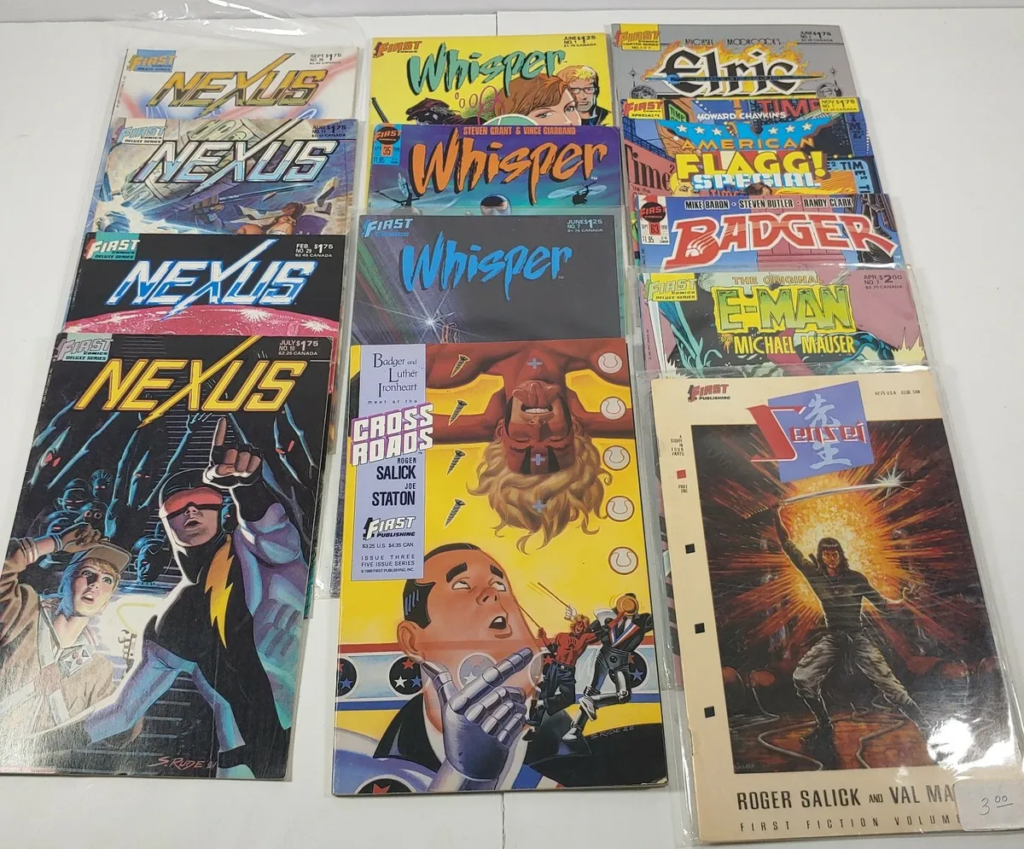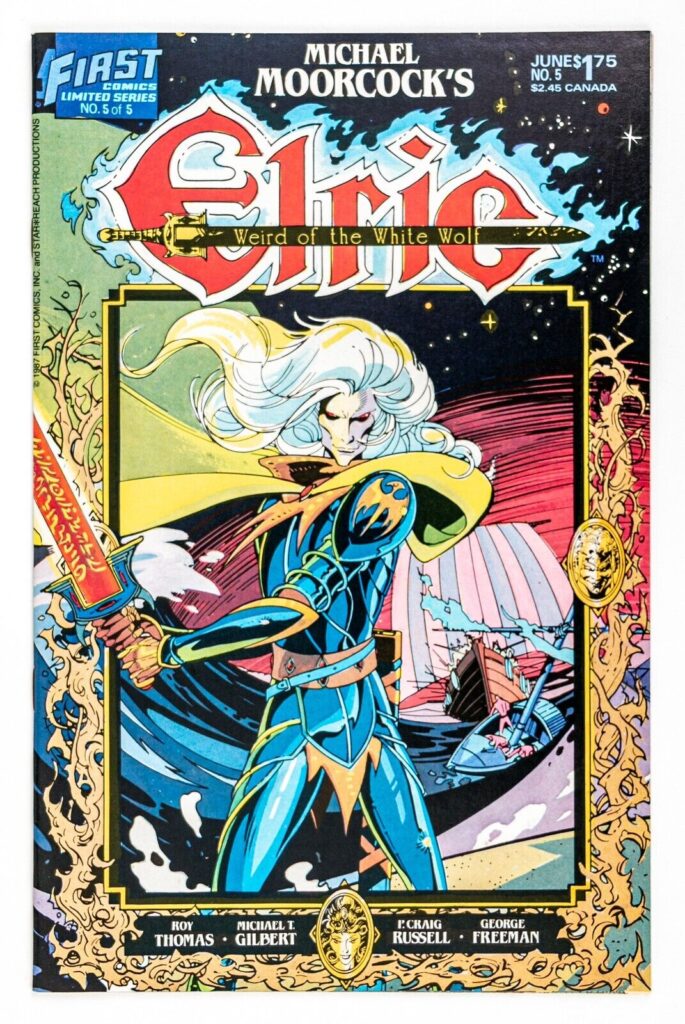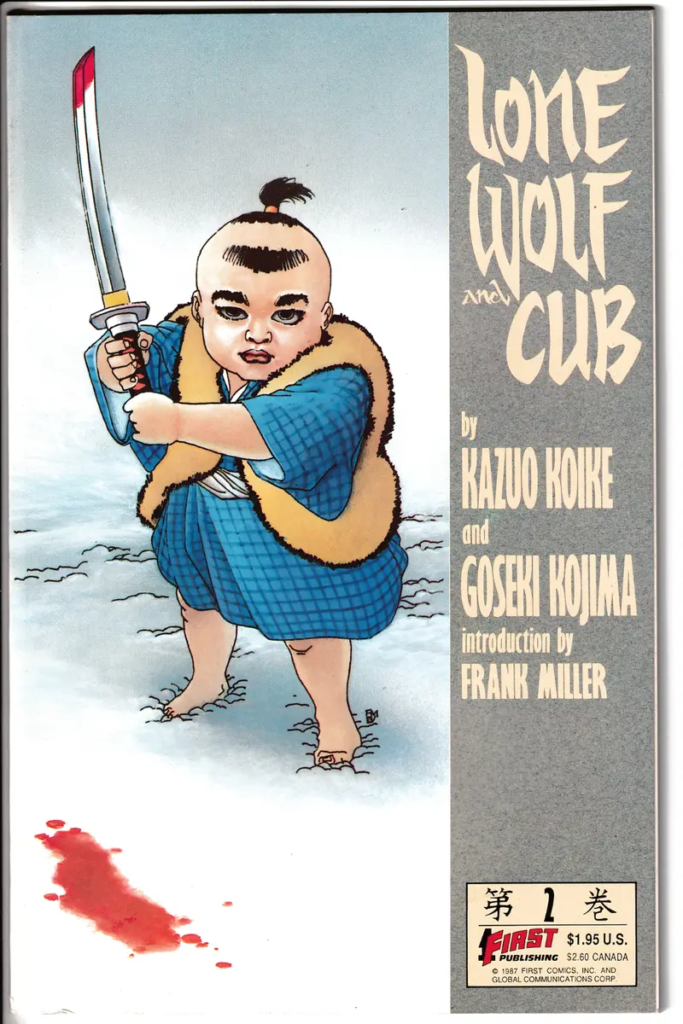Totally 80s Comics – First Comics

It’s no real secret that the man with the golden Rolodex is going to get ahead in life.
I recently talked to one of the guys that runs a publishing house that is usually near the top of the KU store. He had started with an email newsletter. If you wanted a boost as an author you just sent him your book’s info and he’d give you a boost, provided it was science fiction or fantasy, and not romance or porn.
When it was time for him to launch his own company, just think about how many markers he had outstanding.
“If you want good connections, be a good connection,” Vox Day.
Consequently, when Ken Levin wanted to get into the newly booming comic book industry in 1983 he got in touch with Mike Gold. Gold had been with public relations at DC Comics. Meaning he was the guy that would set up the booths at conventions, handle the meet and greets for the writers, and helped arrange private commissions for the artists. And he didn’t just talk to the boys from DC Comics either. The guy that listens to everybody’s problems knows everybody’s problems. Mike Gold was the guy who knew who was unhappy and why.
If it was the usual reasons of; Comic Book Code restrictions, no creative control, and no IP ownership, then Mike Gold had a solution for you. Come to First Comics!
Unlike a lot of indie publishers who started slow and built up their stable of writers with time, First Comics launched out of the gate with a fairly impressive talent lineup. Gold also pinched a lot of Pacific Comics’ writers. This was at the period where Pacific had a perennial cash flow problem, which gave their writers a cash flow problem. Which made their writers look around for greener pastures that were NOT owned by DC or Marvel. Again, Mike Gold had an answer for your problems.
Although, there were some issues with recruiting. Most publishers, either literary or comic books are headquartered in New York City. There is no real advantage to it. It’s the most expensive real estate in America. And it gives them some pretty big liabilities. It’s all about status really. And First Comics was headquartered in Evanston, Illinois. It was hard for New Yorkers to wrap their heads around the concept that publishing was possible outside of The City. Still, enough were willing to throw the dice on this publisher that was in the barbarian outland of Beyond Not Jersey, that First Comics had a pretty decent first year.
****
Grim Jack

Something that made First Comics different was that it had a kind of sort of but not really shared universe. Grimjack is the street name of John Gaunt, a sword-for-hire, ex-paramilitary, war veteran, and former child gladiator. He operates from Munden’s Bar in the Pit, a slum area of Cynosure. Cynosure was a kind of pan-dimensional post-apocalyptic Chicago (pretty much indistinguishable from pre-apocalyptic Chicago but I’ll grant the multiverse thing is new).
Cynosure was meant to connect all of First Comics’ universes without screwing around with the trainwreck that is multiverse proper. It didn’t quite work out and ended up screwing the creator John Ostrander. When First eventually went under there was a big legal problem. While Grim Jack unquestionably was the IP of Ostrander, the setting was the IP of First Comics. And Grim Jack was inseparable from Cynosure.
The issues were eventually resolved and Grim Jack went back into publication, mostly with IDW.
There have been frequent attempts to bring it to the screen. J. Michael Straczynski attempted to bring to big screen back when he was making Babylon 5.
In 2019 the Russo Brothers of Avengers fame made a similar announcement at Comicon, it’s safe to say Covid killed that project. I’m afraid any attempt to make a comic book movie will be met with outright hostility from the studios these days.
Jon Sable Freelance

This was my favorite of the original First’s titles.
Jonathan Sable was a bounty hunter and mercenary who previously had been an athlete in the 72 Olympics. After witnessing the massacre, he marries another of the athletes and moves to Rhodesia to avoid terrorism. Yeah, wrong call. He became a game warden but while he was wardening, his family was murdered. After slaughtering his family’s killer he came back to America and became a mercenary who… Also writes children’s books? Just roll with it, the eighties was a different world.
Mike Grell has been publishing Sable off and on over the years. Usually with IDW and some Kickstarter boxed sets. Still great stuff. If you liked Punisher, you’ll be fine with Sable.
American Flagg

This one had so much promise and did so much failing to live up to it. This had some appeal to me because I was a dumbass college Libertarian and was willing to jump through a lot of mental hoops to try to convince myself something was a lot deeper than it was.
Reuben Flagg, born in 2000 at Hammarskjold Center, Mars, to Axel and Rebecca Flagg, was a stand-up comic and popular TV star of the show Mark Thrust, Sexus Ranger. After he was made superfluous by technology (basically by CG), he joined the Plexus Rangers and emigrated to Earth, being stationed in the Chicago Plexmall. Flagg is Jewish, and his parents’ “undesirably bohemian” attitudes have given him an idealistic view of the United States that runs contrary to the Plex. He has a desire to set things right again, and through inheriting Q-USA, begins to set on that path.
You see in 1996 the Domino Year, Everything collapsed and the US government relocated to Mars (kind of an interesting stand-in for the East Coast elites we have today and godamn it I’m doing it again, after 40 years, I’m trying to make this comic book better than it really was again…)
Look this is basically the story of a fake hero who becomes the hero he’s only pretending to be. Nice stuff provided you don’t read too much into it.
Next!
Nexus

“The lead character, Horatio Hellpop, got his Nexus powers from an alien entity called the Merk. As payment, the Merk required Nexus to seek out and kill a certain quantity of human mass murderers per “cycle”. When the Merk selected a target, Nexus would receive strong headaches and maddeningly anguishing dreams (whose extremely intense episodes caused physical injuries to Hellpop’s body that emulated the dream violence) of his target’s victims until he did his duty. Horatio was reluctant to act as the Merk’s tool, but continued seeking out mass murderers to maintain his power and his sanity so that he could defend his homeworld.”
This one wasn’t for me. In a lot of ways, it was a take-off on the original Space Ghost, making it a boomer’s comic book.
That said, a very well-received boomer comic book that got a bunch of awards. While that may not be a mark of quality it does indicate people actually liked it. At least in the 80s.
Nexus has bounced in and out of publication over the years. Usually with Dark Horse but the creators are talking about bringing it back.
****
Getting back to First Comics.
Mike Gold proved to be fairly aggressive as a publisher and launched an anti-trust suit against Marvel for flooding the market with a bunch of titles in 1983, with a view to shutting out the indies. It was truthfully a well-aimed charge and Marvel was not keen on it going to discovery.
The suit also named World Color Press, (a printing company), for undercharging Marvel but making up for the loss by overcharging the indies. I suspect this side of the equation had less of a basis in fact. It would make business sense to give a bigger company like Marvel more favorable terms and a smaller one less favorable. It may have simply been a strong-arm negotiating tactic. Regardless the suits were settled in 1988.
It also made more sense for Gold to ignore DC comics and go after Marvel. DC was now owned by Time Warner, while Marvel had yet to acquire a powerful corporate overlord.
Regardless, First continued to do well for itself in the mid-eighties with titles like:
Badger

Badger was the superhero identity of Norbert Sykes. A Vietnam vet with multiple-cliche disorder. This thing is way too weird to summarize comprehensibly in a few paragraphs. If you’re a fan of the series then you know it. If not it’s way too late to get into it.
Moving on.
Dreadstar

Vanth Dreadstar is the sole survivor of the Milky Way Galaxy for some reason I don’t remember. He has the standard rag-tag team of loyal (and one disloyal) followers; including a cyborg sorcerer, yes that happened. The first plot was about their struggle to end an ancient war between two powerful, evil empires: The Church of The Instrumentality, run by the Lord Papal; and the Monarchy, administered by a puppet king.
This one started off on Marvel’s Epic Comics, which actually did allow for creator ownership. Jim Starlin moved the series to First after Epic folded. On the strength of his name, it has bounced around a bunch of different imprints. Image, Malibu, Dynamite.
Currently in production and if you want TDS in your indie comics then Dreadstar is for you.
*****
Come to think of it, there may have been another reason Gold didn’t go after DC.
In early 1986 Mike Gold left the company he co-founded and returned to New York with a nice big promotion as senior editor of DC. Where he proceeded to gut First Comics of a lot of its first-chair talent, like Grell, Chaykin, and Truman.
Ken Levin soldiered on, while doubtless dwelling on the importance of non-compete clauses for key talent. In 1986, Levin decided to try to give turnstiles a spin (sorry) and started selling to newsstands as well as comic book shops. I don’t honestly know how much of a success that was.
Regardless, First wasn’t afraid to experiment. It was the first to print a digital comic book.
Shatter

Shatter was a cyberpunk comic when that was still kind of new. Also, nobody knew how to do it right, and honestly, Shatter wasn’t all that different. That said, it was the first digital comic book. The plot lands somewhere between Blade Runner and Bubblegum Crisis.
Oh and by digital comic, I don’t mean it was distributed by Compuserve. I mean it was made on a Mac Plus using MacPaint. The comic book was printed off on a dot matrix printer and sent to the publisher. The results speak for themselves:

Yeah, it was awful.
Apple contacted them and tried to sell them on the benefits of a LaserWriter. They laughed when they heard the price, which was about $20,000 in Today Bucks. My used VW Rabbit was less than the price of one when they first came out. Apple thought it over and decided this was high profile enough for them to eat a bullet and just fucking gave them a LaserWriter.* I was a Mac user at the time and hate them to this day for it.
Eternal Champion by Michael Moorcock

It’s Elric.
You know the story.
Next.
Lone Wolf and Cub

Possibly, the first Manga to come to the US. It was a known property at the time. A couple of movies had made the drive-in circuit in the late seventies; Lone Wolf and Cub and Shogun Assassin. So at least the title was about as familiar as you were likely to get in 1980s America.
You probably know the story’s background. Lonewolf was the Shogun’s Kogi Kaishakunin, fell from grace and became a ronin on the vengeance trail while trying to protect his infant son. Although, First’s version started the tradition of mistranslating Kogi Kaishakunin as “Shogun’s executioner.” While that was his mechanical function, a Kaishakunin is incredibly more complicated as a job title in a very Japanese way.
Sepuku is not an execution, it’s a testament, usually an apology. ”I’m sorry and I mean it t-h-i-i-i-s much” During a seppuku, the principal has technically killed himself, (frankly he did that when he pissed off the Shogun) however the Kaishakunin is just putting the principal out of his misery, sparing him the disgrace of a public display of agony. The Kaishakunin strikes and then the head flips forward on a flap of skin the sword strike has left behind, the head flops forward thus concealing the face in death (kind of a thing in a lot of cultures). Importantly, a Kaishakunin would have fucked up big time if he actually took the head off completely. Then he would have actually executed the principal. In the West, an executioner has such stigma attached they historically wore a mask to conceal their identity. Since a daimyo was of a rank to have the Shogun himself as his second, and since the Tukogawa in question was always “too busy” (read didn’t have the skill), the Kogi Kaishakunin was acting in place of the Shogun himself and was the only other person in Japan who could wear the Shogun’s personal Mon.
Going from executioner to assassin in the West is a big step up.
But when Ogami Itto became a sell-sword, he was falling from Olympus.
That is what was lost in the translation.
First Comics’ last big project was a revival of Classics Illustrated

A questionable idea for a comic book in 1990.
****
First ran into the same problems everyone else did when the comic book crash devastated the indie market.
Its more popular titles like Jon Sable and Dreadstar moved on to greener pastures. When the shops started closing, the money dried up. The talent accepted certain realities and called their friends in New York. First Comics finally declared bankruptcy in 1991 and ceased publication.
This would normally be the part of the article where I would lament the loss of what was, but First Comics came back from the dead. In 2011 Ken Levin resumed publication.
Most of his top-tier talent had long since moved on, but Badger came back. I’m honestly not familiar with the new titles although Space Negro has me vaguely curious. The Yuan Twins are currently listed as the co-publishers. I don’t know anything about them and I’m not going to learn tonight.
Okay, I’m done here.
*This story is possibly apocryphal as I heard it in an 80s comic book shop. But I’m still jealous on general principle.

